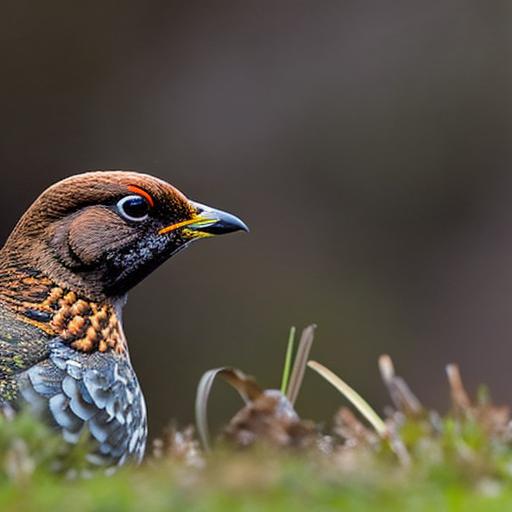Your cart is currently empty!

Hunting Grouse with a 22: The Ultimate Guide to Boosting Your Game!

Table of Contents
Introduction
The rhythmic drumming of a grouse echoing through a crisp autumn forest is a sound that is familiar to many hunting enthusiasts. Grouse hunting has been a time-honored tradition, passed down through generations, each bringing its own evolution of techniques and tools to the table. In recent times, one such tool that has gained immense popularity is the humble .22 caliber rifle. Light, nimble, and precise, the .22 has emerged as a favorite for small game hunters across the world.
While hunting grouse requires a good understanding of the bird’s behavior, habitats, and routines, it’s equally critical to understand your tools and techniques. A .22 rifle, in the hands of a skilled hunter, becomes an extension of the hunter’s own senses, perfectly melding man, machine, and nature into a seamless experience. Yet, this isn’t just a game of chance or basic skills; there’s an art, science, and ethos to hunting grouse with a .22, and this guide aims to shed light on all these aspects.
Whether you are a seasoned hunter looking to refine your grouse hunting techniques or a newbie curious about how best to approach this game, this guide is designed for you. From understanding the intimate details of grouse behavior to choosing the perfect .22 rifle and ammunition for your hunts, every aspect is covered in depth. Our goal is to ensure that by the end of this article, you’ll be well-equipped with the knowledge and strategies to enhance your grouse hunting adventures and take your game to the next level.
Understanding Grouse Behavior
Ah, the grouse! Anyone who’s spent even a smidgen of time hunting these wily birds knows there’s a lot more to them than meets the eye. Let’s dive into the wonderful world of grouse behavior, shall we?
First off, let’s talk habitats. Grouse are the forest’s savvy inhabitants, and they’ve got their favorite spots. Generally, they’re fans of young, dense forests, especially those recovering from fires or logging. The shrubby undergrowth provides ample cover from predators, and the bounty of berries and insects? Well, that’s like their own personal buffet. If you ever find yourself trekking through a woodland with a mix of open clearings and dense shrubs, keep those eyes peeled, you might just be in grouse territory.

Now, onto their daily routines. Grouse are a bit like us in the mornings. Slow starters. They typically hang out on the ground in the wee hours, nibbling on leaves and buds. But come mid-morning, it’s their playtime. If you’ve ever heard a peculiar drumming sound during your forest escapades, you’ve been privy to a male grouse’s performance. This is his way of attracting females, and boy, do they take it seriously. These males will stake out a log or rock (their “drumming log”) and create that rapid thumping sound by beating their wings. It’s their version of a dating profile, broadcasting their readiness to any interested females nearby.
Speaking of seasons, grouse have their own calendar of activities. Springtime? That’s romance season. It’s during this period that you’ll see most of the aforementioned drumming displays. By summertime, female grouse are busy with their chicks, teaching them the ropes and keeping them safe. Fall is a great time for hunters because grouse become less wary and more active, feeding heavily to prepare for winter. And winter? They’re all about survival. You might even find them burrowing into soft snow for insulation against cold nights.
One more thing! Grouse aren’t the greatest at flying long distances. Instead, they’re ambush specialists. They’ll wait until you’re close, relying on their cryptic coloring to remain unseen, and then burst into flight as a surprise tactic. This startle strategy often leaves predators (and hunters) off-balance, buying the grouse precious seconds to escape.
In sum, understanding grouse behavior is like getting an insider’s guide to these forest dwellers. Once you get their rhythms down, you’re not just hunting; you’re engaging in a beautiful dance with one of nature’s most intriguing small game birds. So the next time you’re out in their neck of the woods, remember these tidbits. They might just tip the balance in your favor.
Choosing the Right .22 for Grouse Hunting
Alright, fellow hunters, pull up a stump and let’s chat rifles. Not just any rifles, mind you, but the trusty .22, the unsung hero of the small game world. If you’re pondering the best .22 to accompany you on your next grouse adventure, you’re in the right place. Let’s embark on this journey together, one hunter to another.
Now, before we get lost in the woods of rifle models, it’s essential to remember: the best .22 is the one that feels right for you. Each of us has our preferences based on our hunting style, experience, and, of course, budget. But here are some golden nuggets to help you navigate your choices.
1. Bolt-action vs. Semi-automatic vs. Lever-action: This is the first crossroad you’ll encounter. Bolt-action rifles are often the go-to for many due to their reliability and accuracy. A bolt-action .22 is a classic choice, giving you the precision that’s crucial when hunting small game like grouse. The semi-automatics, on the other hand, offer quick follow-up shots if you miss your first. Handy, right? But keep in mind, they might not match the bolt-action’s accuracy. Lever-action .22s? Well, they’re a blend of the old and new. They bring a touch of the Wild West to your hunting, combining style with functionality.

2. Weight and Length: If you’re going to be traipsing through dense forests and rugged terrains, you want a rifle that doesn’t feel like you’re lugging around a tree trunk. Lightweight .22s are your best companions in these scenarios. But remember, lighter rifles might mean more felt recoil, so find that sweet spot that works for you.
3. The Scope Situation: A good scope on a .22? Some hunters might raise an eyebrow, thinking it’s overkill. But hey, when you’re trying to spot a grouse that’s expertly camouflaged against the woodland floor, a little magnification never hurt anyone. Look for a scope that offers clear optics and holds zero well, especially after those inevitable bumps and knocks in the wild.
4. Ammunition Compatibility: This might sound like a no-brainer, but ensure your chosen .22 is friendly with a variety of ammo types. From subsonic rounds (quieter, and often preferred for stealthy hunts) to high-velocity cartridges, your rifle should feed and fire them without a fuss.
5. Reliability is Key: You don’t want a rifle that throws a tantrum in the middle of a hunt. Reviews are your best friends here. Dive deep into the experiences of other hunters. Which .22s do they swear by? Which ones have let them down?
6. Budget: Last, but by no means least, is the money talk. Like everything in life, with .22s, you often get what you pay for. But that doesn’t mean you need to break the bank. Many mid-range .22 rifles deliver exceptional performance and durability.
To wrap this up, choosing the right .22 for grouse hunting is a bit like dating. You might need to try a few before you find “The One.” But once you find that perfect match, it’s a bond that’ll last many a hunting season. Take your time, do your research, and may your hunts be ever successful!
Essential Gear and Equipment
Alright, fellow hunters, gear up (pun intended)! If you’re set on hunting grouse with a .22, then there’s some essential gear and equipment you shouldn’t overlook. Let’s break it down, and I’ll spill the beans on what’s in my own hunting pack.
1. The Right Ammo: Not all .22 ammo is created equal, especially when we’re talking grouse. You’ll want to be precise and effective, without causing unnecessary damage. For grouse hunting, I’m a big fan of subsonic ammunition. It’s quieter, which means if you miss your first shot (hey, we’ve all been there), you might get another crack without spooking every bird in a three-mile radius. Supersonic rounds have their place, but the loud crack might just leave you watching a flurry of escaping birds.
2. A Trusty Scope: While some old-timers might trust their naked eye or iron sights, I’m all about a good scope on my .22. It’s essential for precision, especially given the grouse’s knack for hiding in the underbrush. Opt for a scope that’s lightweight, durable, and ideally, with multi-coated optics for that crisp, clear image. Trust me, it’s a game-changer.
3. Camouflage and Scent Concealers: Now, grouse have sharp eyes, but they’re not eagle-eyed. Still, blending in can give you a real edge. Think light camo patterns for spring/early fall and darker ones for late fall. And while grouse don’t have the nose of a deer, I always say, “Why risk it?” A little scent concealer or even just staying downwind can keep you off their radar.
4. Quality Field Vest: A field vest is like the Swiss Army knife of clothing. You want one with multiple pockets to stash gear, and preferably, a game pouch in the back for your harvested birds. Pro tip: opt for a vest with padding on the shoulders. It’ll help absorb some of that rifle recoil and keep you shooting comfortably all day.
5. Sturdy Boots: You’re going to be treading through dense underbrush, marshy spots, and everything in between. A pair of waterproof, ankle-supporting boots are worth their weight in gold. Take care of your feet, and they’ll take care of you.
6. Grouse Calls: Alright, so this might venture into advanced territory, but having a grouse call can be quite the trick up your sleeve. While grouse aren’t as responsive to calls as, say, turkeys, in the right situation, a well-executed call might just lure that elusive bird into your sights.
7. Reliable Backpack: Last but not least, a good backpack. You’ll want something that can carry your essentials – extra ammo, snacks (don’t judge me, hunting is hard work), water, and maybe even a first aid kit. Bonus points if it’s got straps or clips for your rifle, giving your arms a break when trekking long distances.
Remember, fellow hunters, hunting grouse with a .22 is both an art and a science. While your skills and knowledge play a massive role, the right gear can make a world of difference. Invest in quality, take care of your equipment, and it’ll take care of you out there in the field.
Tips and Techniques for a Successful Hunt
Alright, fellow hunter, if you’re looking to up your game in the grouse hunting department with a .22, you’re in for a treat. Over the years, I’ve picked up a trick or two that might just make your next hunt the stuff of legends. Let’s get into the nitty-gritty, shall we?
1. Silence is Golden: Ever noticed how grouse have a knack for taking off just when you thought you had the perfect shot lined up? These birds have keen hearing. When you’re out hunting with a .22, which is relatively quieter than a shotgun, you have the advantage. Move slowly, step lightly, and let the silence work in your favor.
2. The Art of Stalking: To get close, you’ve got to think like a grouse. Remember, they prefer to stay grounded during the early hours. Use this time to practice your stalking skills. Keep low, use natural covers, and approach from downwind. Your .22 will give you precision, but it’s your stealth that’ll give you opportunity.
3. Zone In On Your Senses: Sometimes, it’s not about seeing the grouse, but hearing them. Listen for rustling leaves or the faint pecking sound they make when feeding. And keep an ear out for that signature drumming – it can lead you right to Mr. Grouse, waiting to impress his lady friends.
4. Optimal Shot Placement: Now, here’s where the .22 comes into its own. A well-placed shot is key to ethical hunting. Aim for the head or the vital neck area. This ensures a quick, humane kill, reducing the chances of just wounding and losing the bird. Remember, it’s always quality over quantity.

5. Scope It Out: Having a reliable scope on your .22 can be a game-changer. Whether it’s early morning or late afternoon, a good scope can give you that extra edge in clarity. And for those trickier, longer-range shots, the crosshairs can make all the difference.
6. Get To Know Your Ground: Grouse have their favorite haunts. Berry patches, clearings with young saplings, or dense shrubby areas. If you’ve had luck in a spot before, chances are, you might just strike gold there again. Take mental notes or mark your map.
7. Practice, Practice, Practice: Before the season begins, spend some time at the range. Familiarize yourself with your .22’s shooting characteristics. Shoot from different positions – standing, kneeling, or even prone. The more you know your rifle, the better you’ll be when it’s go-time.
8. Patience, My Friend: Sometimes, the hunt is all about waiting. Find a promising spot, make yourself comfortable, and let the grouse come to you. It might not be as adrenaline-pumping as stalking, but it can be equally rewarding.
9. Dress the Part: Camouflage is more than just a fashion statement in the grouse woods. Blend in with your surroundings. And here’s a pro tip: invest in layers. Morning can be chilly, but as you move and the sun climbs, you’ll appreciate being able to shed a layer or two.
10. Celebrate Every Hunt: And finally, remember that every hunt is a lesson. Whether you bag a grouse or simply enjoy a day out in nature, there’s always something to take away. Cherish the experiences, the memories, and the stories.
In the world of grouse hunting with a .22, it’s a blend of skill, patience, and a bit of old-fashioned luck. Keep these tips in mind, and you’re on your way to some truly memorable hunts.
Related Questions
Is hunting grouse with a .22 legal in all states?
Well, it’s a bit of a mixed bag! The legality of hunting grouse with a .22 varies by state. Some states allow it, while others might restrict it in favor of shotguns. It’s crucial to check your local regulations and game laws before heading out. When in doubt, give your local wildlife agency a ring. Better safe than sorry!
How does grouse taste, and are there any popular recipes?
Ah, the taste of victory! Grouse has a delicious, rich, and somewhat earthy flavor, slightly more pronounced than chicken. Many folks love it roasted with herbs or wrapped in bacon. One popular recipe? Pan-seared grouse breasts with wild mushrooms and a touch of white wine. A taste of the wild on your plate!
What’s the difference between hunting grouse and other similar birds?
Grouse hunting is its own little dance. Unlike some other birds, grouse tend to be ground-dwellers and have that explosive take-off which can catch hunters off guard. Plus, their preferred habitat – dense forests and brushy areas – adds to the challenge. Compare this to pheasants or quail, which have different behaviors and habitats, and you’ll find each bird requires its own strategy.
How can I practice my .22 shooting skills in the off-season?
Keeping sharp with your .22 is always a good plan! Head to the shooting range and practice with varying distances and targets. If you’ve got space, set up reactive targets (like spinning or pop-up targets) to simulate the sudden movement of grouse. And don’t forget dry-fire exercises at home (with safety in mind, of course). Practice makes perfect, and come grouse season, you’ll be ready!
Summary
Grouse hunting is more than just a pastime; for many, it’s a connection to nature, a rite of passage, and a treasured tradition. Introducing the .22 rifle into this equation has brought about a blend of modernity and tradition, enabling hunters to approach their prey with precision, respect, and skill.
Throughout this guide, we’ve journeyed through the intricate dance of grouse behavior, the importance of choosing the right rifle and ammunition, and the essentials of gear that make a difference in the field. The techniques and tips shared are a culmination of years of experience, research, and a deep understanding of both the hunter and the hunted. Every aspect, from the bird’s daily routines to the art of stalking, has been covered to give you a comprehensive view of the world of grouse hunting.
But remember, hunting is not just about the catch. It’s about respect for nature, understanding the nuances of the prey, and most importantly, about learning and evolving as a hunter. As with any skill, hunting grouse with a .22 is a continuous journey of growth. Prioritizing safety, ethics, and continuous learning ensures that this tradition remains honorable and is passed on to future generations in its most pristine form.
As you embark or continue on your grouse hunting journey with your trusted .22 by your side, always remember to approach the sport with an open mind and heart. Respect for the grouse, the environment, and fellow hunters is paramount. Here’s to many successful hunts, memorable experiences, and the ever-evolving art of hunting grouse with a .22!

Herb has been a longtime lover of the outdoors. Whether it be hunting, camping, fishing or just getting outside to reset. Proud father and animal lover. Bourbon anyone?

by
Tags:
Comments
3 responses to “Hunting Grouse with a 22: The Ultimate Guide to Boosting Your Game!”
-
[…] Ah, the foraging behavior of the ruffed grouse. Now, there’s a dance of nature that’s a delight to decipher. You see, it’s not just about what they eat, but when and where they’re most likely to find it. Understanding these patterns is like having a cheat sheet for the hunting game. […]
-
[…] out, this article offers practical advice to enhance your hunting experience. So, head over to https://oldoaksyndicate.com/hunting-grouse-with-a-22/ and expand your knowledge in the world of […]
-
[…] and techniques for successfully hunting grouse using this specific firearm. Check out the article here to enhance your hunting skills and make the most of your time in the […]

Categories
- Big Game Hunting (301)
- Deer (202)
- Reviews (3)
- Shooting (16)
- Slingshot (1)
- Small Game Hunting (42)
- Upland Hunting (126)
- Waterfowl Hunting (3)





Leave a Reply